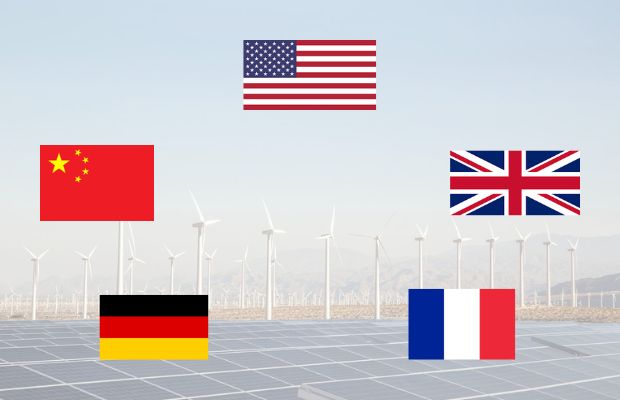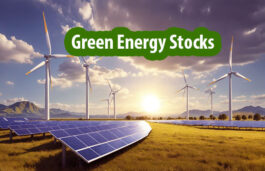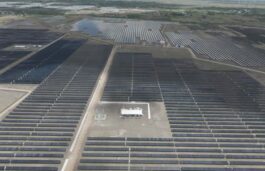Highlights :
- The top 5 most attractive countries for renewable energy investment are the USA, China, the UK, Germany, and France

The governments around the world are looking to accelerate and broaden the scope of their renewables programs. The investors are looking out for the most attractive countries for Renewable Energy investment. But the world stands at the turn to future of energy facing dual visions – need of self-reliance in energy sector in a highly volatile world of present, and the need to mitigate climate change and reducing pollution causing fossil fuels consumption. The former factor has become a novel aspiration of the economies across the globe to help reduce risk of crisis due to their reliance on energy imports in these volatile and unpredictable times.
Ukraine war has only aggravated global energy dependence concerns. Emerging renewables technologies and green fuels could become a key to reducing global reliance on gas as energy security concerns have increased governments’ focus on renewables programmes.
Whatever may be the reason, renewable energy has become a very crucial topic which will steer the world economy and politics for many decades to come. Nevertheless, a shift away from conventional energy requires a kind of investment never seen before. Technological development, infrastructure, public sentiment, and policies will be fundamental in deciding how attractive a country for the investors in renewable space.
We bring you the top 5 most attractive countries for renewable energy investment. The listicle has been arrived at on the basis of several reports and studies that mutually agree on the listing of the 5 most attractive countries for RE investment. These include EY’s Renewable Energy Country Attractiveness Index (RECAI), released in May this year.
#1 USA
The hydrogen and offshore wind are driving the renewable interests in one of the most attractive countries for renewable energy investment in the world. The U.S. Department of Energy is deploying US$10 billion in funding for the advancement of green and blue hydrogen as part of the Infrastructure Investment and Jobs Act, 2021. In order to develop its clean hydrogen network, the North American leader allocated USD 8 billion investment. Furthermore, R&D for clean hydrogen manufacturing and recycling will see an investment to the tune of USD 1.5 billion. This also involves a clean hydrogen electrolysis program aimed at reducing the production cost.
Wind energy is another sector the government is promoting for reducing country’s dependence on conventional sources of energy. Recently, the Bureau of Ocean Energy Management held a wind energy auction for two lease areas offshore of North and South Carolina. These projects, on full operation, may have a capacity of around 1.3 GW. This is a part of larger push in the sector as in 2021 the US identified up to seven potential offshore wind lease sales by 2025. With a single 30 MW operating offshore wind project so far, the country’s market is ambitious of gigantic change in its energy bandwagon.
#2 China
The biggest energy consuming country on the planet, China, aims to reach carbon neutrality by 2060. The country looks to peak its carbon emissions by as early as 2030. To achieve such an ambitious milestone, the country needs to adopt a more extensive approach in swapping the sources of its humongous energy requirement. Indeed, the South Asian powerhouse has its renewable plans in pipeline.
China Mainland has announced it will prioritize geothermal, hydrogen and tidal energy in an effort to develop new and renewable energy sources. More unique is its efficient region specific approach – evaluating the presence of natural resources and industrial development in each district. Chinese leader also indicated that the government will seek to increase the development of large, integrated wind and solar project campuses. Interestingly, China has urged developers to set up projects in grasslands and forested regions, and on land that is unsuitable for agricultural use. Unsurprisingly, the country offers a huge developmental opportunity and, hence, is one of the most attractive countries for renewable energy investment.
#3 United Kingdom
In past couple of years, UK has also made a huge progress in renewable sector to become one of the top three most attractive countries for renewable energy investments. The country has been attracting investments via auctions for battery storage and floating offshore projects. This is also partly due to the Government setting new wind and nuclear targets in the face of the global energy price crisis. Thanks to several policy decisions and major moves in the private sector.
Through its Energy Security Strategy the country set an ambition for 95% of the UK’s electricity generation to be low-carbon by 2030, increasing to 100% by 2035. Notably, government classifies renewables and abated natural gas as low-carbon energy sources.
UK has also aspires to host at least 50GW of offshore wind capacity, of which up to 5GW should be floating, by 2030. In addition, UK looks to achieve 10GW of green and blue hydrogen production by 2030. The country has already made a mark. For instance, for the first time in more than a decade, plots of Scotland’s seabed were auctioned to renewable energy developers to develop 24.8GW projects. Furthermore, UK’s decision to relax planning rules for battery energy storage projects has made the UK an attractive market for energy storage investors.
#4 Germany
Germany has one of the most ambitious green energy targets in the world. The European nation aims to achieve a 100% green power by 2035. And wasn’t that big in itself, the country aims to achieve 80 per cent of this goal by 2030 in order to increase its energy security. Germany is known in the renewable energy world for its solar energy growth, with capacity of roughly 60 GW in 2021. It aims to triple its solar expansion from 7GW to 20GW annually in 2028.
Germany is not staying behind in other renewable sectors either. Earlier this year, the country announced its aims to triple annual additions of onshore wind from 3GW to 10GW in 2027. In addition, it will try to more than double on its offshore wind, with cumulative capacity increasing to 70GW in 2045. Interestingly, Germany will phase out its nuclear power by the end of this year itself.
#5 France
France has set ambitious 2050 renewables targets, with a short-term target of 32% renewables in energy mix by 2030. It plans for 100GW of renewable power installed capacity which includes 40GW of offshore wind projects. In addition, the country will also be spending around €5bn ($5.3bn) for decarbonisation of its heavy industry.
As a part of its short-term goal of 2030, the French government will invest EUR 1 billion in renewable energy innovation projects. In March 2022, the French PM announced the launch of two floating wind farm projects in the Mediterranean coast of metropolitan France. These farms, with a capacity of approximately 250 MW each, will be completed later. They will also have two extensions of 500 MW each.
With so much scope of development in renewable, France is among the most attractive countries for renewable energy investment in the world.



























